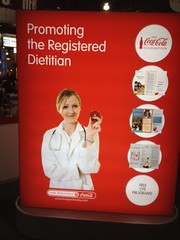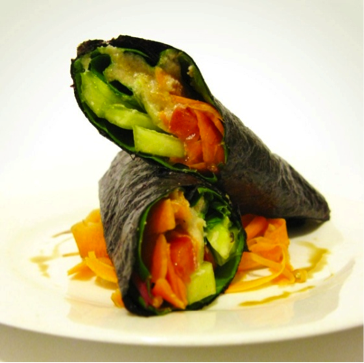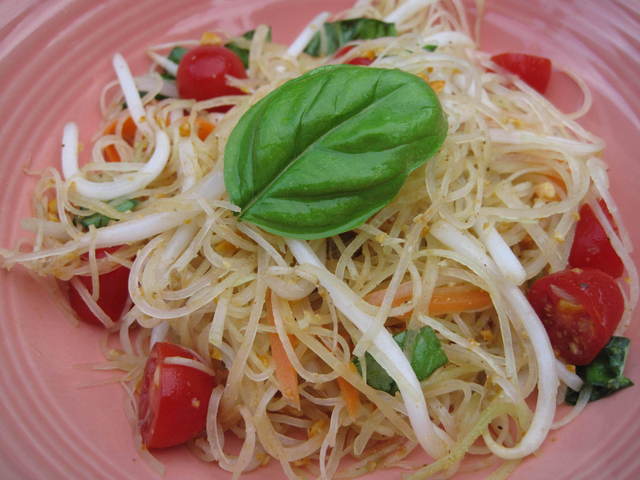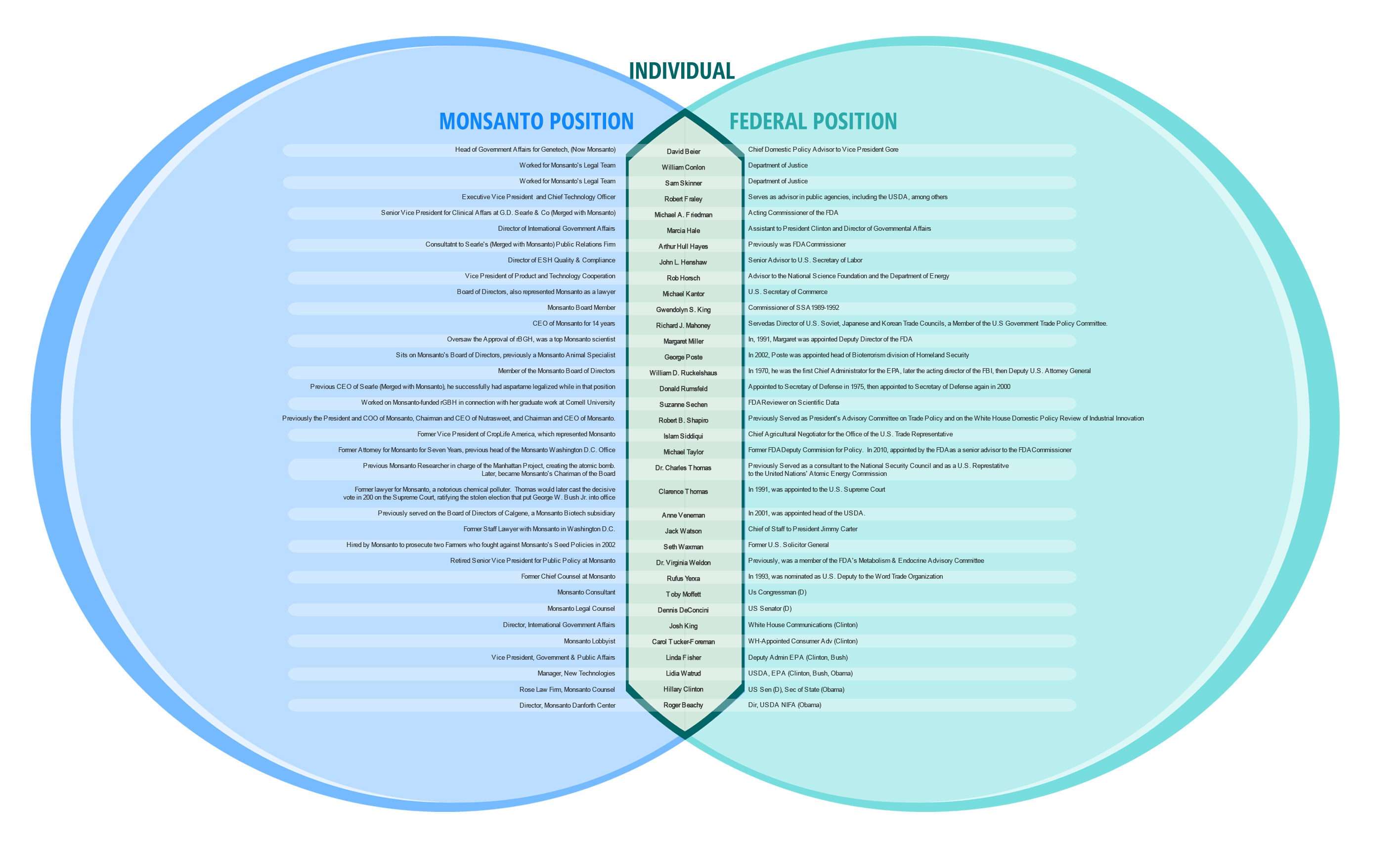Booth displays at Academy of Nutrition and Dietetics Expo. (photos by Andy Bellatti)
I recently attended the annual gathering of the largest trade group of nutrition professionals, which I alsocovered last year. Look out for complete report from me in the coming months. Meantime, I am pleased to share the experience of one registered dietitian, Andy Bellatti.
The Academy of Nutrition and Dietetics (AND) hosted its
2012 Food & Nutrition Conference and Expo(FNCE) earlier this month. Sadly, the event once again (see last year’s
report) demonstrated how this registered dietitians’ accrediting organization drags its own credential through the mud by prioritizing Big Food’s corporate interests over sound nutrition and public health.
Nutrition Conference or Junk Food Expo?
Academy “partners,” which enjoy top sponsorship status at the expo, included the National Dairy Council, Coca-Cola, and the Hershey Center for Health and Nutrition (yes, the chocolate company). Event “premier sponsors” included General Mills, PepsiCo, and Mars. As a dietitian, I am embarrassed that the nation’s largest nutrition trade organization maintains partnerships with companies that contribute to our nation’s diet-related health problems.
The expo floor did have a few bright spots, such the Center for Science in the Public Interest, Meatless Mondays, and independent companies promoting relatively whole-food products (and advocating for California’s GMO-labeling initiative), such as Lundberg Farms, Nature’s Path, Manitoba Harvest, and Mary’s Gone Crackers. However, these booths were small and more difficult to locate, while the largest and flashiest booths belonged to the likes of PepsiCo, Coca-Cola, McDonald’s, Hershey’s, Monsanto, and the Corn Refiners Association. (Notably, many of these companies are funding the No campaign on GMO labeling.) Even the candy lobby had a booth for the first time this year (not surprisingly, their message was one of “moderation,” that meaningless term). Many of these booths shamelessly pandered to me and my colleagues. Coca-Cola for instance, claimed to “promote the registered dietitian.” How exactly they do this is unclear; “co-opt” would be a more accurate term.
Educational Sessions or Big Food Propaganda?
In addition to dominating the expo hall, Big Food also often asserted unilateral control over the messaging at many of the educational sessions. One session on food allergies (“Beyond Belly Aches: Identifying and Differentiating Food Allergies and Intolerances”) was mostly National Dairy Council propaganda. Lactose-free dairy products were presented as the best (and sometimes, only) choice for individuals with lactose intolerance in order to “prevent nutrient deficiencies” and confer alleged benefits of dairy, such as weight loss and reduced risk of heart disease and diabetes (these claims were not referenced).
These oft-repeated talking points by the dairy industry are a slap in the face to nutrition science; all the nutrients in dairy are available in plant-based foods, and the research linking dairy intakes to weight loss and decreased risks of diabetes and heart disease is tenuous at best, and is often sponsored by the dairy industry. (The weight loss claim has even been
deemed by the federal government as deceptive.) Many dietitians specializing in food allergies who attended the session
expressed their disbelief on Twitter. Others I spoke to walked out, insulted by what they considered to be unhelpful and inaccurate information.
A session on children and beverages titled “Kids Are Drinking What?” – also presented by the National Dairy Council – was essentially an hour-long advertisement for milk. The dairy reps acknowledged how they target African-American and Hispanic communities with a “drink more milk” message, which I found particularly disturbing as both ethnic groups have high rates of lactose intolerance. The dairy council also kept repeating a new slogan – “one more cup” – which, again, is supposed to “reduce nutrient deficiencies.” Notably one of the most glaring deficiencies among U.S. children – low fiber intake – was not brought up at all; and no wonder, since dairy products contain no fiber.
Even more disturbing was all the hand-wringing over children’s high intake of sugar-sweetened beverages, as if the dairy council really cares about kids’ health. This alleged concern disappeared when I asked about the added sugar in chocolate milk. The panelists’ – all of whom were employed by the National Dairy Council — answer was that chocolate milk is a “nutrient-dense” beverage. Never mind how, with three teaspoons of sugar per cup, one serving of chocolate milk supplies the maximum daily amount of added sugar for children ages four to eight,
as recommended by the American Heart Association.
Big Food’s presence was sometimes more covert. One session on food additives was sponsored by the
International Food Information Council, the same food industry front group that last year
assured us that pesticides are safe. Striking a similar chord, this panel explained how additives are safe because, after all, strawberries and coffee contain “chemicals” responsible for their taste and aroma. So, the logic train went, if we eat strawberries and coffee without a care, why do we fear controversial preservatives such as BHT and BHA? (The Center for Science in the Public Interest
recommends avoiding BHA.)
Panelist Dr. Roger Clemens enthusiastically defended chemical additives while mocking survey results that showed how a significant portion of the public mistrusts the Food and Drug Administration. When I asked him why other countries have banned additives that the FDA has not, I was told it is simply a result of “a different group of scientists” arriving at “a different conclusion.” How convenient. What concerned me even more was how most of the audience appeared to find Dr. Clemens’ defense of additives humorous. Sadly, it appeared that Dr. Clemens did not have to work very hard to convince many dietitians that chemical additives were safe.
Does Sound Nutrition and Common Sense Require a Debate?
Some semblance of balance was attempted at two sessions. At one, titled “Why Can’t We All Just Work Together? Public Health vs. Industry,” panelist Margo Wootan, of the Center for Science in the Public Interest, explained how industry and public health have two very different goals. Food industry consultant Beth Johnson, meanwhile, claimed the food industry is committed to improving Americans’ health by continually reformulating products to include more whole grains and lower sugar and sodium. But this approach is really not going to cut it given the seriousness of diet-related health problems this nation faces. To my surprise and disappointment, during the Q&A, one RD sided with the food industry saying that consumers should be blamed for not making healthy choices.
At another point-counterpoint session, this one on processed foods, Susan Crockett from kids’ cereal giant General Mills passionately defended processed foods. Her opponent, Jessica Kolko, an RD from Whole Foods, explained how Americans’ reliance on highly processed foods is responsible for a litany of public health ills. Ms. Kolko argued that the solution is for people to increase their intake of “real food.” While this session finally delivered the “eat real food” message that I espouse (shouldn’t all RDs?), why was a critique of the food industry framed as a “controversial” topic that can only be discussed in a debate format?
Taking Back the RD Credential
On the bright side, there is an emerging subgroup of RDs who are increasingly unhappy with Big Food’s ubiquity in the Academy, and who voice their disappointment. The
Hunger and Environmental Nutritiondietetic practice group, of which I am a member, concerns itself with issues of corporate control, food justice, environmental regulations, and other “big picture” ideas. This summer, they released their
guidelinesfor responsible corporate sponsorship. They encompass environmental sustainability, humane labor practices, and support of sound public health policy. The Academy leadership would greatly benefit from reading and applying these criteria more broadly.
At its annual “Film Feastival,” HEN hosted a screening of
Split Estate, a captivating and sobering documentary about the tragic consequences of fracking in New Mexico and Colorado. In between harrowing stories of children, adults, and ecosystems sickened by pollutants, oil and gas industry representatives reassured viewers that fracking was a completely safe practice. As the documentary went on, their lies were exposed, and I thought of the striking similarity to Big Food’s spin and untruths; the very companies that my professional organization partners with. Bleak subject matter aside, I was happy to spend a few hours utilizing my brain, thinking critically, and listening to a panel of concerned individuals – a doctor, an RD, an activist, and a farmer – all advocating against powerful lobbies that prioritize profits over health. Sound familiar?
Now more than ever, members of the Academy who recognize the insidious nature of partnering with Big Food must speak up and let the leadership know how and why these partnerships are detrimental to the profession. We cannot allow ourselves to be steamrolled by the inane notion put forth by many in power that partnering with the likes of PepsiCo and McDonald’s benefits our profession and the health of Americans. It is simply untrue. I am growing increasingly tired of having to defend the credential I worked so hard for, which in many circles is seen as promoting Diet Coke and Baked Cheetos. We will never be taken seriously as nutrition experts when our messaging and credential is co-opted by junk food companies who think we are just an easy sell.
I urge my colleagues to think critically, ask tough questions, and relentlessly defend the ideas of healthful, real food. Yes, you will have detractors. Yes, at times you may feel you face a well-oiled – and well-budgeted – PR machine that is ready to discredit and stomp you. However, this is not the time to claim defeat. Many people are now recognizing the power of food to promote – or destroy — health. It is up to us, as registered dietitians, to take back our credential.






 Inflammation is a common response the body has to injury, pain, illness, and stress. If your body has a temporary, acute inflammatory response, it is simply a sign of natural healing.
Inflammation is a common response the body has to injury, pain, illness, and stress. If your body has a temporary, acute inflammatory response, it is simply a sign of natural healing.


